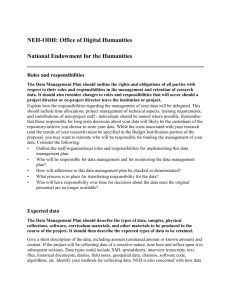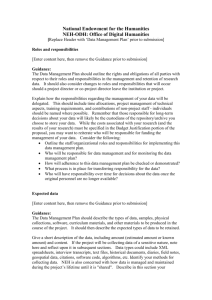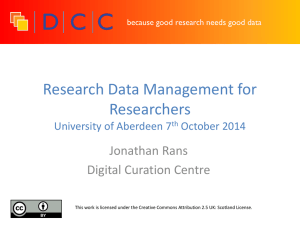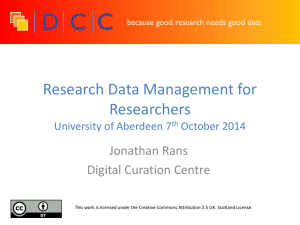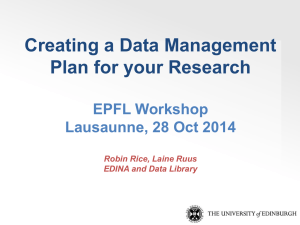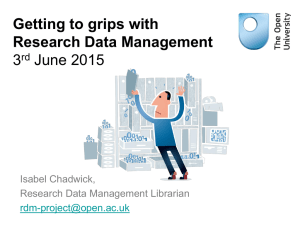Research data
advertisement
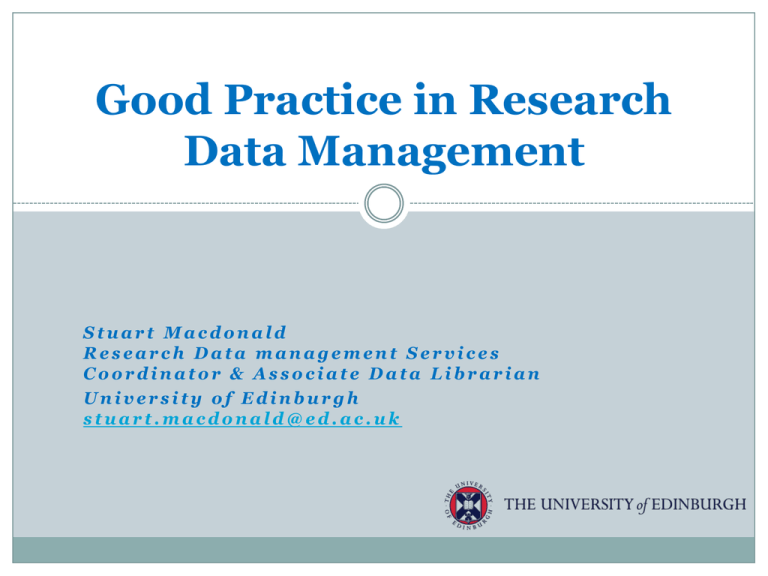
Good Practice in Research
Data Management
Stuart Macdonald
Research Data management Services
Coordinator & Associate Data Librarian
University of Edinburgh
stuart.macdonald@ed.ac.uk
Running order
Introductions
Research data explained
Research data management & data management plans (DMPs)
Organising data
File formats & transformation
Documentation & metadata
Coffee break
Storage & security
Data protection, rights & access
Sharing, preservation & licensing
Research data
Defining research data
Research data are collected, observed or created,
for the purposes of analysis to produce and
validate original research results.
Both analogue and digital materials are ‘data’.
Lab notebooks and software may be classed as
‘data’.
Digital data can be:
o
created in a digital form ('born digital')
o
converted to a digital form (digitised)
Research data can also be regarded as situational
i.e. the same digital information or materials may
be data for some research questions but not others
Data can also be created by researchers for one
purpose and used by another set of researchers at a
later date for a completely different research
agenda.
Types of research data
Instrument measurements
Experimental observations
Still images, video and audio
Text documents, spreadsheets,
databases
Quantitative data (e.g. household
survey data)
Survey results & interview
transcripts
Simulation data, models & software
Slides, artefacts, specimens,
samples
Sketches, diaries, lab notebooks …
Research data management &
data management plans
(DMPs)
Research data management
Research data management is caring for,
facilitating access to, preserving and adding
value to research data throughout its lifecycle.
Data management is part of good research
practice.
Good research needs good data!
Activities involved in RDM
Data management
Planning
Creating data
Documenting data
Storage and backup
Sharing data
Preserving data
Why manage your data well?
So you can find and understand it when needed.
To avoid unnecessary duplication.
So you can finish your PhD!
To validate results if required.
So your research is visible and has impact.
To get credit when others cite your work.
Drivers
Funder policies
http://www.dcc.ac.uk/resources/data-management-plans/funders-requirements
http://www.dcc.ac.uk/resources/policy-and-legal/overview-funders-data-policies
University’s RDM Policy
University of Edinburgh is
one of the first few
Universities in UK who
adopted a policy for
managing research data:
http://www.ed.ac.uk/is/research-data-policy
The policy was approved by
the University Court on 16
May 2011.
It’s acknowledged that this is
an aspirational policy and
that implementation will take
some years.
http://www.ed.ac.uk/is/research-data-policy
What is a DMP
DMPs are written at the start of a project to define:
What data will be collected or created?
How the data will be documented and described?
Where the data will be stored?
Who will be responsible for data security and backup?
Which data will be shared and/or preserved?
How the data will be shared and with whom?
DMPs are often submitted as part of grant applications,
but are useful whenever you are creating data.
DMPonline
Free and open web-based tool to
help researchers write plans:
https://dmponline.dcc.ac.uk/
It features:
o
Templates based on different
requirements
o
Tailored guidance (disciplinary,
funder etc.)
o
Customised exports to a variety
of formats
o
Ability to share DMPs with
others
DMPonline screencast:
http://www.screenr.com/PJHN
Tips to share
Keep it simple, short and specific.
Avoid jargon.
Seek advice - consult and collaborate.
Base plans on available skills and support.
Make sure implementation is feasible.
Justify any resources or restrictions needed.
Also see: http://www.youtube.com/watch?v=7OJtiA53-Fk
Organising data
Why?
To ensure your research data files are identifiable
* by you and others in the future*
Organising and labelling your research data files and folders will
help to:
prevent file loss through overwriting, deleting, misplacing
facilitate location and future retrieval
save you time (mostly in the future)
It’s good research practice!
How?
With an organised, consistent & disciplined approach:
Setting conventions at the start of your project
Establishing a good directory structure
Project_1
Appropriate file naming & renaming conventions
– don’t make it up as you go along!
File version control - a clear audit trail exists for tracking the
development of a data file and identifying earlier versions
File naming
Good file naming will:
Provide context for the contents (describe your file)
Distinguish files from each other (different versions too)
Good file names:
Avoid special characters (“£$%!”¬&*^()+=[]{}~@:;#,.<>)
Use_underscores_rather_than spaces
Include date of creation or modification eg. YYYY_MM_DD
Be consistent!
Version control
Useful
Provides audit trails (versions are identifiable and trackable)
Files are easier to locate, browse and sort by you and others
Files retain a useful context if moved to other storage platforms
(eg. data repository)
Suggested strategies
Use sequential number system ( FileName_Date_v1, _v2, _v3)
Avoid potentially confusing labels (FileName_final, _final2)
Discard obsolete versions (but NEVER the raw copy!)
Use auto-backup system, rather than archiving yourself
File formats &
transformation
File formats
Formats encode information in a standard form to
enable another programs to access data within it.
Example: .html, .csv, .jpeg, .tex, .pdf
Files encoded as text or binary files:
•
Text encoding: machine- and human-readable. Less
likely to become obsolete .txt, .csv, .html, .xml, .tex, etc.
•
Binary encoding: only readable with appropriate
software .fcp, .xlxs, .docx, .psd, .nc, etc.
Recommended formats
Type
Recommended
Avoid for sharing
Tabular data
CSV, TSV, SPSS portable
Excel
Text
Plain text, HTML, RTF, PDF/A Word
only if layout matters
Media
Container: MP4, Ogg
Codec: Theora, Dirac, FLAC
Quicktime, H264
Images
TIFF, JPEG2000, PNG
GIF, JPG
Structured data
XML, RDF
RDBMS
See also UKDA File Formats Table: http://www.data-archive.ac.uk/create-manage/format/formats-table
File format migration
If you need to convert or migrate your data files
(change the format) be aware of the potential risk
of loss or corruption of your data.
Take appropriate steps to avoid/minimise it
Always test the files you convert or migrate
Data normalisation
You may also use the data normalisation process:
This means to convert data from one format
(e.g. proprietary) into another for use or
preservation (e.g. ASCII).
Data compression
When compressing your data files (storage,
sending, sharing) you encode the information
using fewer bits than the original representation.
Compression programs like Zip and Tar.Z
produce files such as .zip, .tar.gz, .tar.bz2
Data transformation
When you need to compute new values from your
data. Three transformation techniques:
Aggregation (combine data into larger units)
Anonymisation (remove personal information)
Perturbation (distortion) - Example: population data in
Census are sometimes released with perturbations as a
trade-off for geographical detail.
Documentation & metadata
What it is
Documentation (intending for reading by humans)
Contextual information
o
Aims & objectives of the originating project
Explanatory material
o
o
o
o
data source
collection methodology & process
dataset structure
technical information
Metadata (intended for reading by machines)
‘data about data’
descriptors to facilitate cataloguing and discoverability.
What it does
Documentation
Metadata
Facilitates understanding and
Provides context for your data,
interpretation of your data.
o
@ project level
o
@ file or database level
o
It explains the background to the
research that produced it and its
methodologies.
Its describes their respective
formats and their relationships
with each other.
@ variable or item level
It supplies the background to the
variables and their descriptions.
particularly for those outside your
research environment, discipline and
institution.
Tracks its provenance.
Makes your data easier to find and
use.
Makes your data discoverable.
Helps support the archiving and
preservation of your data.
Why it is necessary
To help you …
remember the details of your data
archive your data for future access & re-use
To help others …
discover your data
understand the aims and conduct of the originating
research
verify your findings
replicate your results
Types of documentation
Varies from project to project and may include:
Laboratory notebooks.
Field notes.
Questionnaires.
Methodologies.
Standard operating procedures.
Reports of decisions made that relate to conduct of
the research.
Types of metadata
Categories of metadata
Descriptive
o Title
o Author
o abstract,
o location,
o keywords for discoverability
Administrative
o terms of access
o rights management
o preservation
Structural
o components of the dataset
o their relationship to each other
Acknowledgement: www.tvtechnology.com
Storage & security
Basic Principles
Use managed, network services
whenever possible to ensure:
o Regular back-up
o Data Security
o Accessibility
Avoid using portable HD’s,
USB memory sticks, CD’s, or
DVD’s to avoid:
o Data loss due to damage, failure,
or theft
o Quality control issues due to
version confusion
o Unnecessary security risks
Digital preservation Coalition’s new promotional
USB stick:
https://twitter.com/digitalfay/status/411444578
122600450/photo/1
Secure storage & regular backup
Make at least 3 copies of the
data:
o
on at least 2 different media,
o
keep storage devices in separate
locations with at least 1 offsite,
o
check they work regularly,
o
ensure you know the process and
follow it.
One copy=risk of data loss
Ensure you can keep track of
different versions of data,
especially when backing-up to
multiple devices.
o
Use a versioning software e.g.,
Tortoise, Subversion
•CC image by Sharyn Morrow on Flickr
•CC image by momboleum on Flickr
Keeping Sensitive Data Secure
Ensure PC’s, laptops, and
portable data storage devices are
stored securely and encrypted if
necessary.
University of Edinburgh Data
Encryption policy warns users
that "medium and high risk
personal data or business
information must be encrypted if
it leaves the University
environment".
However, be aware that any
encrypted data will be lost if you
lose the password/encryption
key or if the disk image is
corrupted or the hard disk fails.
System lock: Image by Yuri Yu. Samoilov Flickr (CC-BY)
https://www.flickr.com/photos/110751683@N02/
Data Disposal
Ensure disposing confidential data
securely.
o
Hard drives: use software for secure
erasing such as BC Wipe, Wipe File,
DeleteOnClick, Eraser for Windows;
‘secure empty trash’ for Mac.
o
USB Drives: physical destruction is
the only way
o
Paper and CDs/optical Discs:
shredding
The University of Edinburgh has a
comprehensive guide to the disposal
of confidential and/or sensitive
waste held on paper, CDs, DVDs,
tapes, discs and other holding
devices.
http://www.ed.ac.uk/schools-departments/estatesbuildings/waste-recycling/how/confidential-waste
Data protection, rights &
access
Things to think about
Ethics
Requirements relating to data that relates to human subjects.
Privacy, confidentiality & disclosure
Data protection
Intellectual Property Rights (IPR)
Copyright
Ethics
Ethics committees
Review research applications and advise on whether they are ethical.
Safeguard the rights of research participants.
Participants
Must be fully informed as to the purpose, methods and intended uses
of the research, and advised of what their involvement will entail.
o
NB As funding councils expect that you will be sharing your data, best to include
mention of this when consent is obtained.
Their participation must be voluntary, fully informed and free of any
coercion.
Confidentiality of information collected and anonymity of subjects
must be respected at all times.
Privacy, confidentiality & disclosure
Privacy
An entitlement of the subject.
Subsequent handling, storage and sharing of data must be carefully
managed to preserve the privacy of the subject.
Confidentiality
Refers to the behaviour of the researcher, whereby the privacy of the
subject is maintained at all times.
Disclosure
Must be guarded against!
Various techniques to avoid it, whether for ethical, legal reasons or
commercial reasons, e.g.
o
o
o
removing identifiers from personal information
aggregating geographical data to reduce precision
anonymising data – but without overdoing it!
Data protection
1988 Data Protection Act
Research data, specifically
what you can do with it,
falls within the scope of
this Act.
Failure to observe its
requirements can get you
into a lot of trouble!
Intellectual property rights (IPR)
IPR
Legally recognized exclusive rights and protection for
creations of the intellect.
IPR grants exclusive rights to creators to
o
Publish a work
o
License its distribution to others
o
Sue if unlawful copies or use is made of it
Copyright
Can be contentious & complex!
When data are archived or
shared, the creator retains
copyright.
Where data are then structured
within a database as a result of
substantial intellection
investment, an additional
‘database right’ can also sit
alongside the copyright attaching
to the data contents.
Freedom of information
The Freedom of
Information Act 2000
(FOIA) …
… gives a right of access to
information held by 'public
authorities‘, which includes
most universities, and
… covers all records and
information held by them ,
whether digital or print, current
or archived.
Therefore a very good idea
to anticipate such requests
and ensure that your data
are ready to meet them!
Sharing, preservation &
licensing of data
Data preservation
Preservation is key to the long term existence and
future accessibility of research data …
… by the original creator (yourself)
… by future researchers
… by any other person
Mapping the preservation process, workflow devised by DCC (Digital Curation Centre)
Data preservation
Storage and access media
(formats, hardware, software)…
… are superseded
… fail (software/hardware)
… deteriorate
Worth thinking about
preservation at the
planning stage.
Data preservation …
… requires a trusted repository.
Research-funders
Institutional (UoE)
Edinburgh DataShare http://datashare.is.ed.ac.uk/
Discipline-specific
ESRC data store http://store.data-archive.ac.uk/store/
Archaeology Data Service http://archaeologydataservice.ac.uk/
Discipline-agnostic
Figshare http://figshare.com/
Data sharing
What is it?
Who’s involved?
Is making your research
available for others to
reuse and build upon.
data creator
data repository managers
secondary data user
technologists
Benefits of sharing for …
… the researcher
Comply with funding council
requirements
… research & society
Avoid duplication of effort & resources
Publicly funded research is available
Academic & scientific integrity
Research can be validated
Increase reach & impact (reputation)
increases transparency & accountability
facilitates scrutiny of research findings
prevents fraud
Increase visibility of research
Long-term data storage (preservation)
Extend reach of original research
Enables future retrieval (you & others)
Fosters collaboration
Informal drivers for sharing
‘Open’ everything
Because it’s possible!
“… we have the technologies to permit worldwide availability and distributed process of
scientific data, broadening collaboration and
accelerating the pace and depth of
discovery…”
John Willbanks, VP Science, Creative Commons
… science
… source
… standards
… knowledge
… government
… content
Open data!
“… By open data in science we mean that it is freely
available on the public internet permitting any user to
download, copy, analyse, re-process, pass them to
software or use them for any other purpose without
financial, legal, or technical barriers other than those
inseparable from gaining access to the internet itself.”
See more at:
http://pantonprinciples.org/#sthash.8D4LWqpi.dpuf
Formal drivers for sharing
Funders (public funding bodies)
Consider your future application to one of these funding bodies:
You will be required to share, unless data protection applies
You want your research to have a wide impact, don’t you?
You want others to use/cite your work (recognition)
Barriers to sharing
“Scientists would rather Valid barriers to sharing
share their toothbrush
the researcher
than their data!”
(intellectual property issues)
Carol Goble, Keynote address, EGEE
(Enabling Grid for EsciencE) ’06 Conference
the institution
(commercial value)
the subject
(confidentiality, data protection)
http://openclipart.org/detail/172856/toothbrush-by-bpcomp-172856
Planning for sharing
Issues to consider
“Everyone in a research team
should have a clear sense of their
responsibilities in ensuring that …
research data are of the highest
quality; … are well documented so
that other researchers can access,
understand, use and add value to
them … independently of the
original investigators.”
MRC Guidance on Data Management Plans
Future ‘share-ability’ of the data
• format
• software
• anonymisation
• documentation
• ethics
• consent & confidentiality
Timescale for release (embargo)
Infrastructure for sharing
Rights management & licensing
Data licensing
Why?
The license explicitly states
how your data may be used
How?
Repository rights statement’
Creative Commons (CC)
http://wiki.creativecommons.org
Makes them available to others
Ensures your data are open!
Open Data Commons (ODC)
http://opendatacommons.org/
*Recommended for data*
Supporting you for RDM
RDM support
Make the most of local support!
Postgraduate Research Administrators in your School
Your Academic Support Librarian
Data Library staff
IT staff in your School
Your School’s Ethics Committee
Check out what facilities are in your school/centre
Ask your supervisor for advice
General RDM queries can be sent to the Helpline who will
direct them as appropriate
Useful links
Record Management: Taking sensitive information and personal data
outside the University’s computing environment
http://edin.ac/1hZaL07
UK Data Archive: Anonymisation
http://www.data-archive.ac.uk/create-manage/consent-ethics/anonymisation
UK Data Archive: Ethical/Legal
http://www.data-archive.ac.uk/create-manage/consent-ethics/legal
Dublin Core metadata creator
http://www.dublincoregenerator.com/generator_nq.html
Digital Curation Centre (DCC): Data management plans
http://www.dcc.ac.uk/resources/data-management-plans
Thank You!
Any questions?
